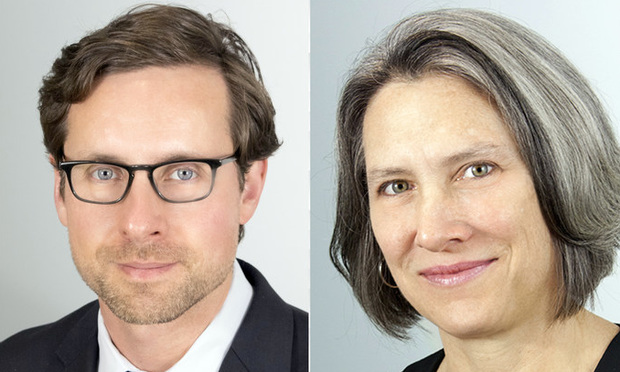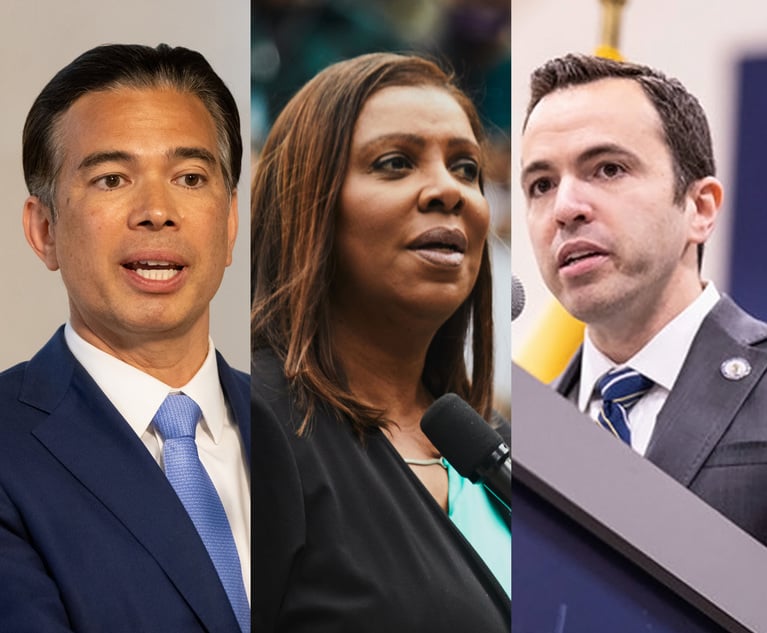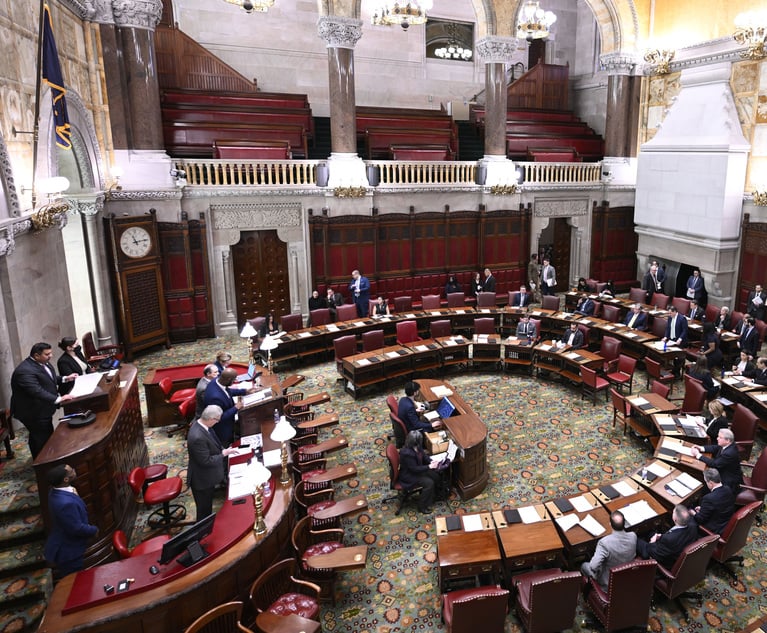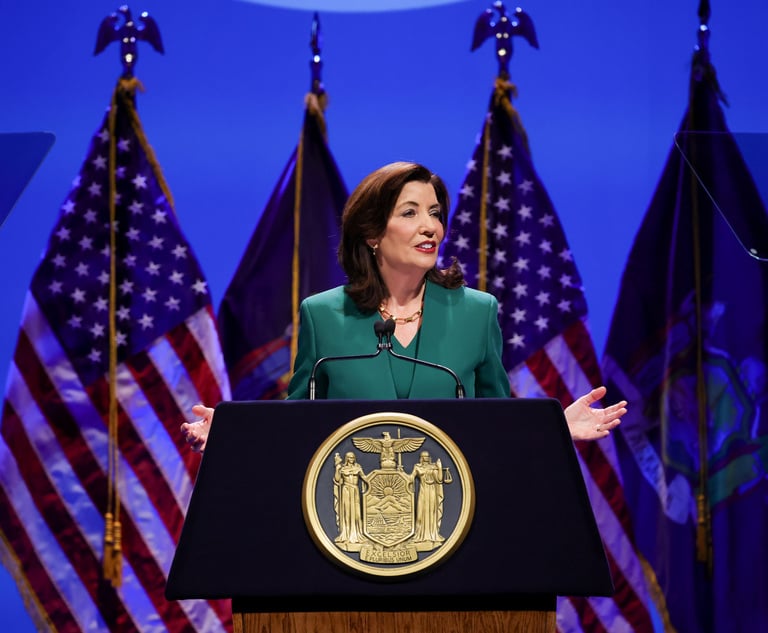Challenges Ahead on New York's Path to Carbon Net Zero
New York state recently enacted a sweeping new law to curtail greenhouse gas emissions from virtually all sources over the next 20 to 30 years. The law contains no specific regulatory roadmap and instead leaves the details to be developed over the next three years with the state Department of Environmental Conservation and the Public Service Commission taking leading roles. As New York takes up the hard work of developing a regulatory path forward, it will need to tread carefully to withstand the public and legal scrutiny that lies ahead. In their Domestic Environmental Law column, Karen Meara and Christopher Rizzo have identified three significant challenges that the state will face as well as possible solutions.
October 23, 2019 at 12:45 PM
8 minute read
 Christopher Rizzo and Karen Meara, Carter Ledyard & Millburn.
Christopher Rizzo and Karen Meara, Carter Ledyard & Millburn.
New York state recently enacted the Climate Leadership and Community Protection Act, a sweeping new law to curtail greenhouse gas emissions from virtually all sources over the next 20 to 30 years. To meet these ambitious targets, New Yorkers will have to change virtually every aspect of how they live. Unlike a similarly ambitious New York City law enacted in April that targets emissions from large buildings, however, the Act contains no specific regulatory roadmap and instead leaves the details to be developed over the next three years with the state Department of Environmental Conservation (DEC) and the Public Service Commission (PSC) taking leading roles. This lack of detail perhaps explains the relative calm that followed the Act's passage. As New York takes up the hard work of developing a regulatory path forward, it will need to tread carefully to withstand the public and legal scrutiny that lies ahead. We have identified three significant challenges that the state will face as well as possible solutions.
Framework: The Climate Leadership and Community Protection Act. The Act sets limits on emissions of carbon dioxide and its equivalents from all sources at 60% of 1990 levels by 2030 and 15% of 1990 levels by 2050. The remaining emissions are to be offset through reforestation and other carbon capture means. Beyond that, the Act divides emissions sources into two major categories: electric generation and everything else, including buildings, transportation and industry. As to electric generation, by June 30, 2021 the PSC must issue an order requiring electric utilities like Con Edison to secure 70% of their electric supply from renewable sources (excluding nuclear) by 2030 and 100% from "zero emission" sources (including nuclear) by 2040.
As to everything else, the Act contemplates a three-year policy-making process involving a Council of 22 appointees from the governor and legislative leaders (including major state agency heads). The Council will involve various advisory groups and solicit substantial public comment before adopting a final "scoping" plan by Jan. 1, 2023 for achieving the 2030 and 2050 requirements. By Jan. 1, 2024, the DEC must promulgate rules to achieve the statutory emissions limits, "reflecting in substantial part the findings of the scoping plan … ."
Challenges on the Road To Greening the Grid. New York is off to a good start in greening its electricity grid. In 2018 New York derived 28 percent of its electricity from renewable sources (i.e., not including nuclear energy) and 58 percent from zero emission sources (including nuclear). And the state continues to dramatically ramp up support of renewable energy projects. In the past two years alone, the state has entered into contracts for approximately 4,700 megawatts of electricity from renewable sources like offshore wind and utility-scale solar. On these facts, New York seems well positioned to achieve its 100% zero emissions target in 20 years. Anticipated changes in supply and demand, however, complicate that picture. For example, Indian Point nuclear power plant, with approximately 2000 MWs of zero emission generating capacity—is scheduled to be shut down by 2021. And while aggressive efforts to improve energy efficiency are expected to reduce demand over current trends, other anticipated changes, such as increased use of electric vehicles, and electrification of building heating systems, are expected to substantially increase demand. Thus, the scale of renewable energy projects that will be required is unprecedented in the northeast, if not the country—requiring careful attention to transmission challenges and local siting objections. The creation of new transmission lines is particularly important as much of the solar and wind power is upstate and much of the demand is downstate.
But transmission projects may face a regulatory challenge created, in part, by New York state itself. Every linear transmission project, whether an interstate natural gas pipeline or an electric cable, involves some amount of tree clearing, wetlands disturbance, stream crossings and disturbance of sediment. All such projects, whether proceeding under federal or state jurisdiction, must go through environmental review. When §401 of the U.S. Clean Water Act applies, the state must issue a water quality certification that affirms the project will comply with state water quality standards. In recent years, DEC has set an increasingly high bar for obtaining those certifications (albeit in the context of natural gas transmission lines) that has effectively blocked several major transmission projects. See, e.g., Constitution Pipeline Company v. New York State Department of Environmental Conservation, 868 F.3d 87 (2d Cir. 2017) (affirming DEC denial of water quality certificate to a new natural gas pipeline). DEC and the PSC can expect opponents of major transmission projects to use these precedents.
The Elephant in the Room: Vehicle Emissions. Vehicles are by far the single greatest source of GHG emissions in New York state, accounting for 46% of the total in 2018. Recognizing that the Act's emissions limits can't possibly be met without addressing the transportation sector, the Act expressly requires DEC's rules to include "measures to reduce emissions from" sources with a "cumulatively significant impact" on GHG emissions "such as internal combustion vehicles that burn gasoline or diesel fuel." Federal law, however, preempts states from regulating tailpipe emissions or fuel economy of private vehicles. Federal courts take a broad view of the preemption clauses of the Clean Air Act and Energy Policy and Conservation Act and have used the laws to strike state laws that even indirectly regulate vehicle emissions and fuel economy.
Nevertheless, there are at least three steps New York can take to reduce vehicle emissions. First, New York can expand efforts to reduce vehicle miles travelled by encouraging use of public transportation, expanding the availability of public transportation, encouraging carpooling, and exacting tolls on driving in congested areas. The state's congestion pricing law, expected to be implemented in Manhattan in 2021, is but one example of a legal mechanism expected to reduce car use. Second, the Act contemplates changes in land use laws to indirectly get at vehicle emissions by encouraging denser development that could be served by public transport and discouraging sprawl (i.e., Smart Growth). Finally, much of New York and its communities were designed around driving. Development patterns are well-established. Reductions in vehicle emissions must, therefore, also come from a shift to electric vehicles. New York cannot force that shift because of federal preemption but it can build the infrastructure to support it (i.e., charging stations) and provide financial incentives such as gas taxes and an expanded rebate program, to encourage electric vehicle purchases. In fact, New York has committed $250 million to constructing fast charging infrastructure throughout the state through the EVolve program.
Reining in Building Emissions on Main Street. Perhaps the biggest challenge facing the state is the political difficulty of imposing short-term costs on individual residents for long-term cost savings and environmental benefits. There is simply no path to the carbon free future envisioned in the Act that does not involve mandating or strongly incentivizing individual homeowners to change their heating and cooling systems, replace their appliances, improve home insulation and make other costly changes. The state has tools it could use to achieve reductions in building emissions including carbon taxes on inefficient buildings and mandating emission limits (as New York City has just done for buildings over 25,000 square feet). But they will come at a big cost for owners of smaller buildings, particularly single-family homeowners that dominate the housing market. The median household income in the state is approximately $65,000. Even where existing equipment is reaching the end of its useful life, households are unlikely to upgrade to greener alternatives unless they are affordable and comparably priced to fossil fuel burning predecessors. A successful set of regulations must recognize these financial limitations and include financing mechanisms that will put the necessary upgrades within reach or offset the disproportionate impact of a carbon tax.
Final Thoughts. While this article focuses on some of the challenges facing the Act, there are reasons for optimism. First, the state is already aggressively working to remake its electric grid and incentivize electric vehicles—two vital components of achieving a carbon neutral economy. In other words, by the time DEC issues its 2024 regulations, New York will already be closer to the Act's requirement of net zero emissions by 2050. Second, the Act's passage is sure to engender a whole new wave of innovation that may, 10 years from now, make some concerns seem quaint. For example, if improvements in energy storage could eliminate the challenges associated with the cyclical nature of wind and solar power and satisfy peak demand, the capacity of the existing bulk electric supply would be substantially expanded, even with new demands for power from electric cars and heat. Similarly, as some see opportunities in retrofitting existing buildings to be more efficient, the cost and disruption of making such improvements is likely to come down.
Karen Meara and Christopher Rizzo are attorneys in the environmental and land use group of Carter Ledyard & Milburn.
This content has been archived. It is available through our partners, LexisNexis® and Bloomberg Law.
To view this content, please continue to their sites.
Not a Lexis Subscriber?
Subscribe Now
Not a Bloomberg Law Subscriber?
Subscribe Now
NOT FOR REPRINT
© 2025 ALM Global, LLC, All Rights Reserved. Request academic re-use from www.copyright.com. All other uses, submit a request to [email protected]. For more information visit Asset & Logo Licensing.
You Might Like
View All

Federal Judge Pauses Trump Funding Freeze as Democratic AGs Plan Suit
4 minute read
Relaxing Penalties on Discovery Noncompliance Allows Criminal Cases to Get Decided on Merit
5 minute read
Bipartisan Lawmakers to Hochul Urge Greater Student Loan Forgiveness for Public-Interest Lawyers
Trending Stories
Who Got The Work
J. Brugh Lower of Gibbons has entered an appearance for industrial equipment supplier Devco Corporation in a pending trademark infringement lawsuit. The suit, accusing the defendant of selling knock-off Graco products, was filed Dec. 18 in New Jersey District Court by Rivkin Radler on behalf of Graco Inc. and Graco Minnesota. The case, assigned to U.S. District Judge Zahid N. Quraishi, is 3:24-cv-11294, Graco Inc. et al v. Devco Corporation.
Who Got The Work
Rebecca Maller-Stein and Kent A. Yalowitz of Arnold & Porter Kaye Scholer have entered their appearances for Hanaco Venture Capital and its executives, Lior Prosor and David Frankel, in a pending securities lawsuit. The action, filed on Dec. 24 in New York Southern District Court by Zell, Aron & Co. on behalf of Goldeneye Advisors, accuses the defendants of negligently and fraudulently managing the plaintiff's $1 million investment. The case, assigned to U.S. District Judge Vernon S. Broderick, is 1:24-cv-09918, Goldeneye Advisors, LLC v. Hanaco Venture Capital, Ltd. et al.
Who Got The Work
Attorneys from A&O Shearman has stepped in as defense counsel for Toronto-Dominion Bank and other defendants in a pending securities class action. The suit, filed Dec. 11 in New York Southern District Court by Bleichmar Fonti & Auld, accuses the defendants of concealing the bank's 'pervasive' deficiencies in regards to its compliance with the Bank Secrecy Act and the quality of its anti-money laundering controls. The case, assigned to U.S. District Judge Arun Subramanian, is 1:24-cv-09445, Gonzalez v. The Toronto-Dominion Bank et al.
Who Got The Work
Crown Castle International, a Pennsylvania company providing shared communications infrastructure, has turned to Luke D. Wolf of Gordon Rees Scully Mansukhani to fend off a pending breach-of-contract lawsuit. The court action, filed Nov. 25 in Michigan Eastern District Court by Hooper Hathaway PC on behalf of The Town Residences LLC, accuses Crown Castle of failing to transfer approximately $30,000 in utility payments from T-Mobile in breach of a roof-top lease and assignment agreement. The case, assigned to U.S. District Judge Susan K. Declercq, is 2:24-cv-13131, The Town Residences LLC v. T-Mobile US, Inc. et al.
Who Got The Work
Wilfred P. Coronato and Daniel M. Schwartz of McCarter & English have stepped in as defense counsel to Electrolux Home Products Inc. in a pending product liability lawsuit. The court action, filed Nov. 26 in New York Eastern District Court by Poulos Lopiccolo PC and Nagel Rice LLP on behalf of David Stern, alleges that the defendant's refrigerators’ drawers and shelving repeatedly break and fall apart within months after purchase. The case, assigned to U.S. District Judge Joan M. Azrack, is 2:24-cv-08204, Stern v. Electrolux Home Products, Inc.
Featured Firms
Law Offices of Gary Martin Hays & Associates, P.C.
(470) 294-1674
Law Offices of Mark E. Salomone
(857) 444-6468
Smith & Hassler
(713) 739-1250






